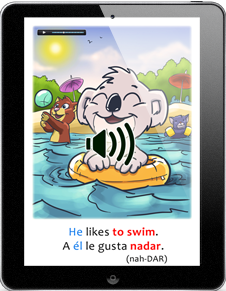Spanish for Kids from BookLingual uses a bilingual storybook approach for teaching children how to read, understand, and speak Spanish. This is an immersion, multi-sensory method that can be used with preschoolers through about age ten. Older students and adults can use it as well, but the drawings and stories appeal most to young children.
Storybooks have colorful illustrations by Goran Pesic. Text accompanied by text written in both English and Spanish. The text is written with color coding that identifies words that correspond directly with one another in both languages. Also, stories frequently repeat common phrases such as, “Put on your coat” (“Ponte tu abrigo”), “Put on your cap,” (“Ponte tu gorro”), and “Put on your gloves” (“Ponte tus guantes.”) This helps children build their vocabulary through repetition in slightly different sentences.
The Complete Spanish for Kids eBook Bundle includes 32 storybooks, a Parent’s Guide, and a Super Quick Guide to Spanish, all as digital downloads. The Complete Spanish for Kids Total Learning Set includes all of the above plus five paperback storybooks, a poster, and a backup CD-ROM with the 32 storybooks.
The digital storybooks can be read on computers, tablets, or phones (although most phone screens are really too small). They include page-by-page audio narration plus simple games and activities at the end of each story. The publisher recommends that children begin by listening to the story read aloud by the computer or tablet. Then go back and read the story in your own voice one or more times. (You can always use the audio if you forget how to pronounce a word.) After reading the story, you can help your child complete the activities or games. These might be simple reading comprehension questions, a word search, or other activities that will take just a few minutes to complete. Answer keys follow immediately after each page. Other suggestions for expanding the lessons on Spanish as well as on the themes of the stories are included in the digital Parent’s Guide. Preschoolers and non-readers can learn Spanish by simply listening to the stories until they are ready to read the storybooks for themselves. With older students, the artwork provides visual clues, so you might cover up the English words and have your child try reading only the Spanish.
The Super Quick Guide to Spanish is worth printing out so that you have it handy. This seven-page guide covers pronunciation and some grammar basics.
Storybooks cover quite a bit of vocabulary, including many of the most basic words and phrases. There are 10 books for level 1, 12 for level 2, and 10 for level 3. (The publisher tells me they are working on levels 4 and 5.) So the program gradually increases in difficulty. Children should reread each storybook until they are familiar with its vocabulary.
The Total Learning Set adds five paperback readers featuring the character Bilingual Benny. (Bilingual Benny shows up in some other stories as well.) These readers are designed in the same fashion as the digital storybooks, but they give children another option to reinforce learning, an option that doesn’t rely on an electronic device. The digital storybooks can take a while to load depending upon your device, so the print versions might also be good when you don’t have time to load a digital storybook.
The concept of these bilingual storybooks is really quite simple: children acquire a second language in an enjoyable format that uses natural language. Parents who do not already know Spanish can learn right along with their children. In fact, parents should try to employ new Spanish vocabulary words in other contexts to reinforce learning. In addition, children who already speak Spanish but cannot read it can use the storybooks to learn to read Spanish.
One complete storybook is available free at the publisher’s website so you can try it out yourself before buying.











